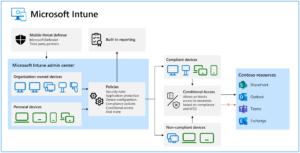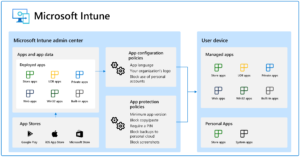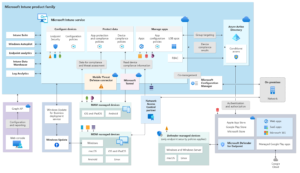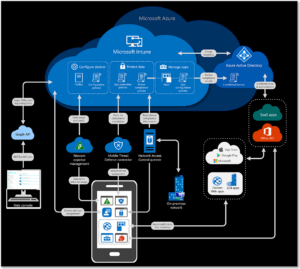
Introduction
In today’s world, the era of digital transformation is in full swing. As businesses across the globe adapt to the new normal, there’s a growing emphasis on digital tools and technologies that can streamline operations, enhance productivity, and safeguard corporate data. Amidst a plethora of tools available, Microsoft Intune emerges as a leading service, providing comprehensive solutions for mobile device and application management.
What is Microsoft Intune and Its Purpose?
Microsoft Intune, a key component of Microsoft’s robust Enterprise Mobility + Security (EMS) suite, is a cloud-based service that primarily focuses on Mobile Device Management (MDM) and Mobile Application Management (MAM). This powerful tool empowers your IT department with the capability to control how your organization’s devices are used, and how data within these devices is accessed and shared.
The purpose of Microsoft Intune is multi-fold. It serves to not only ensure a secure and productive workplace environment, but also provide seamless control over enterprise devices and applications. This is particularly significant in the current scenario where remote work is prevalent. Through Microsoft Intune, businesses can maintain high productivity levels and ensure the security of their data, even in the face of increasingly mobile and remote workforces.
The Business Benefits and Typical Use Cases of Intune
The inclusion of Microsoft Intune in a business’s tech stack brings an array of benefits. Here are some key advantages:
- Enhanced Security: Intune gives you control over how and where your business data is accessed, considerably strengthening your data security profile.
- Greater Control: Intune offers extensive control over the devices used by your employees and the applications on these devices, facilitating effective device and application management.
- Scalability and Flexibility: As a cloud-based service, Intune scales with your business. Whether you need to manage a few devices or several thousand, Intune is up to the task. Moreover, it allows for the management of devices and applications regardless of their location, an essential feature for businesses with remote teams.
- Improved Productivity: Intune enables employees to access company data and applications from anywhere, at any time. This not only supports remote work but also boosts productivity by ensuring that work isn’t constrained by location or time zone.
- Cost-Efficiency: Intune helps reduce costs associated with maintaining on-premises hardware for device management. Additionally, by proactively managing and securing devices and applications, it helps prevent security incidents that could lead to costly data breaches or system downtime.
Typical use cases for Microsoft Intune span a broad range. For businesses with diverse and remote workforces, Intune facilitates efficient device management. For organizations implementing a Bring Your Own Device (BYOD) policy, Intune ensures that employee devices can be securely used for work purposes. For IT departments looking to deploy and update enterprise applications across multiple devices, Intune streamlines the process and makes it more manageable.
Exploring Microsoft Intune’s Features, Apps Management, and Data Access
Microsoft Intune is feature-rich, offering capabilities such as app deployment, device compliance checks, and remote actions (like device wipe), among others. It also allows for the management of a wide variety of applications – mobile apps, web-based apps, and even desktop apps across different platforms.
While Intune provides access to organizational data, it’s crucial to note that it does not access personal data stored on a device, respecting the privacy of users in a BYOD environment. This means employees can use their devices for work without worrying about their personal information being accessed or controlled by the company.
Microsoft Intune’s High-Level Architecture and Integration with Azure Products
At its core, Microsoft Intune is a cloud-based service which forms an essential part of the Microsoft 365 and Azure ecosystems. The high-level architecture of Intune primarily revolves around its integration with Azure Active Directory (Azure AD) and the Microsoft Endpoint Manager admin center.
Azure AD provides identity services that applications use for authentication and authorization to protect your resources from unauthorized access. Microsoft Intune leverages Azure AD for device registration, identity management, and conditional access policies.
The Microsoft Endpoint Manager admin center is the centralized portal through which all device and application management activities take place. It offers a unified, cloud-based solution to manage all your endpoints.
Microsoft Intune doesn’t operate in a vacuum and has significant integrations with other Azure products:
- Azure Active Directory (Azure AD): As mentioned earlier, Intune integrates with Azure AD for device registration, identity management, and implementing conditional access policies. For example, you can use Azure AD to enforce policies that only grant access to managed and/or compliant devices.
- Azure Information Protection (AIP): Intune can work in conjunction with AIP to protect and manage the usage of your sensitive data. Intune can ensure that AIP policies are applied to your documents and emails, thereby preventing unauthorized access or sharing.
- Azure Advanced Threat Protection (ATP): ATP identifies, detects, and helps investigate advanced threats, compromised identities, and malicious insider actions directed at your organization. Intune can feed device information to ATP, providing another layer of data for ATP to analyze when detecting threats.
- Azure Monitor: Microsoft Intune uses Azure Monitor under the hood to provide you with log and telemetry data. This can help your IT team troubleshoot issues, create reports, and gain insights into your IT environment.
- Azure Logic Apps: You can utilize Azure Logic Apps to automate workflows without writing a single line of code. Intune data can trigger these automated workflows, enabling advanced and automated management scenarios.
Integration with Microsoft Defender for Endpoint
Along with the above Azure products, Intune also seamlessly integrates with Microsoft Defender for Endpoint, a comprehensive, cloud-based, endpoint security solution. Defender for Endpoint leverages AI to prevent, detect, investigate, and respond to advanced threats on your organization’s networks.
When integrated with Intune, Defender for Endpoint can provide detailed device threat information that can be used to define compliance policies in Intune. If a device is found to have a high-risk score as determined by Defender for Endpoint, a compliance policy in Intune can mark this device as non-compliant, triggering conditional access policies that restrict the device’s access to organizational resources until the issue is resolved.
In addition, Intune can deploy Microsoft Defender for Endpoint to your Windows 10 devices, ensuring they are protected and that threat data is consistently sent back for analysis.
Integration with Windows Autopilot
Windows Autopilot is another integral part of the Microsoft ecosystem that integrates with Microsoft Intune. Windows Autopilot is a collection of technologies used to set up and pre-configure new devices, getting them ready for productive use. This solution enables an IT department to achieve device deployment with little to no infrastructure to manage, with a process that’s easy and straightforward.
Microsoft Intune works with Autopilot by allowing IT admins to create Autopilot deployment profiles in Intune and then assign these profiles to devices, thereby automating the provisioning and setup process. This seamless integration simplifies the process of deploying new devices, ensuring they are set up correctly from the get-go, and enhancing overall operational efficiency.
In summary, Microsoft Intune’s high-level architecture and its integration with Azure products, Microsoft Defender for Endpoint, and Windows Autopilot create a comprehensive, interconnected environment that supports efficient device and application management, advanced security, and simplified IT operations.
Is Microsoft Intune a Monitoring Tool?
While Microsoft Intune’s primary functions revolve around mobile device and application management, it does have monitoring capabilities. Intune allows IT administrators to monitor devices and applications for compliance with security policies. Although Intune doesn’t serve as a full-scale monitoring tool, its ability to oversee device and app usage adds an extra layer of security to an organization’s IT infrastructure.
Understanding Intune’s Association with Office 365 and Azure
Microsoft Intune is integrated within Microsoft 365, previously known as Office 365, adding another dimension to Microsoft’s holistic productivity suite. It’s also a critical component of the Microsoft Enterprise Mobility + Security suite, which is part of Azure’s offerings. Hence, Microsoft Intune enjoys a significant association with both Office 365 and Azure, offering businesses a comprehensive, interconnected solution for their productivity, security, and management needs.
Microsoft Intune and BYOD Policies: Device Wiping, GPS Tracking, and Platform Support
As businesses increasingly embrace Bring Your Own Device (BYOD) policies, the need for effective management of these personal devices is more critical than ever. Intune provides a solution to this by offering the ability to remotely wipe a personal device, protecting company data if the device is lost or stolen. However, Intune respects the privacy of its users and does not have GPS tracking capabilities, ensuring personal data and locations are not accessible.
Intune is platform-agnostic, offering support across Windows, macOS, Android, and iOS. This extensive compatibility allows businesses to manage a wide array of devices under the BYOD policy, ensuring no device falls outside the scope of secure, effective management.
Intune identifies a device using unique identifiers such as the Device ID or IMEI. This unique identification allows for precise device tracking and management. As for the number of devices Intune can manage, there’s no predefined limit, making it an apt tool for businesses of varying sizes.
What is the Intune Company Portal?
The Microsoft Intune Company Portal is an app provided by Microsoft for your organization’s employees. The app is designed to give employees secure access to the company’s resources, applications, and information on their corporate and personal devices.
Here are some of the main functions and benefits of the Microsoft Intune Company Portal:
- Access Company Resources: The Company Portal provides a convenient, central location from which employees can install apps, including both web apps and public store apps, that have been approved and provided by the company.
- Self-Service Management: It empowers users by enabling them to manage their own devices. For example, users can enroll their devices in Intune, check the compliance status, locate, restart, or wipe their device if it’s lost or stolen.
- Unified Interface: The Company Portal presents a unified interface, regardless of the platform (iOS, Android, macOS, Windows), making it easy for employees to navigate and use.
- Customizable Interface: The Company Portal can be customized to align with your company’s branding, which helps to create a consistent experience across all company apps and resources.
- Support and Guidance: The portal provides support and guidance to users, including direct communication from IT regarding necessary actions for maintaining compliance.
In essence, the Microsoft Intune Company Portal is an essential tool in modern device management strategy, making it easier for employees to work securely and efficiently, and enabling IT to manage and secure devices proactively.
Assessing the Disadvantages of Using Microsoft Intune
Even with its robust capabilities, Microsoft Intune has a few drawbacks. For starters, the learning curve can be steep for those unfamiliar with the Microsoft ecosystem. It may take some time to become proficient in its usage and management.
Secondly, if your business operates across multiple tenants or subscriptions, managing them with Intune can be complex. The tool doesn’t inherently support multi-tenant management, potentially complicating the process for larger organizations.
Lastly, although Microsoft is committed to updating and improving Intune, there can sometimes be delays in the deployment of new features or updates, especially when compared to other industry competitors.
The Three Benefits of Using an Information System Like Microsoft Intune
An information system like Microsoft Intune offers three major benefits:
- Improved Decision Making: Information systems provide data-driven insights that lead to better strategic decisions, and Intune is no different. It gives visibility into the status and security of your devices and applications, aiding in proactive decision making.
- Increased Efficiency: Through the automation of routine tasks such as app deployment and device compliance checks, Intune significantly increases operational efficiency.
- Enhanced Communication: With Intune, everyone in your organization can access the applications they need from any device, promoting seamless collaboration and communication
Conclusion
In conclusion, Microsoft Intune, as integrated into our Oneteam Managed IT Services, is more than just a mobile device management solution. It’s a comprehensive tool that can bolster your business’s security, control, productivity, and cost-efficiency.
By choosing Teknertia and our Oneteam Managed IT Services, you align your business with a partner committed to securing and enhancing your IT operations. Our minimum requirement for partnership is to have at least 10 paid users, but we are open to working with companies of all sizes that understand the importance of a reliable, secure IT infrastructure and are ready to invest in Microsoft licensing.
By proactively minimizing the occurrence of issues, we align our interests with yours, moving away from the traditional break-fix model to a model focused on mutual success. Join us on this journey as we ensure a secure, efficient digital future for your business.
















